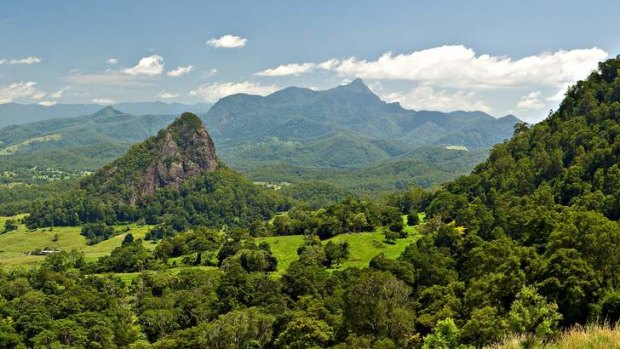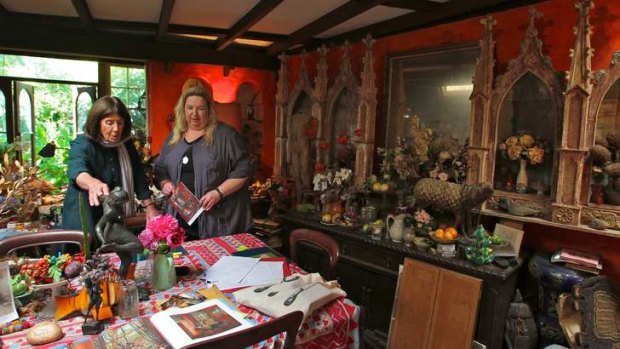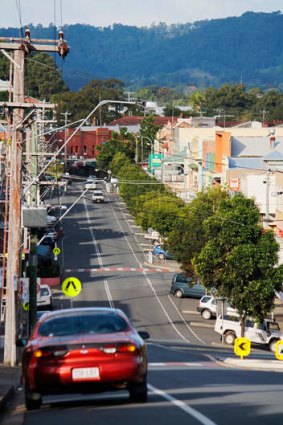
Lush hour: the Tweed Valley.Credit: Corbis
The Tweed region is home to a vibrant cultural scene its residents are only too happy to promote, writes Lance Richardson.
"The land is high and hilly about it," wrote Lieutenant James Cook in 1770 after spying a jagged peak on the east coast of Australia, "but it is conspicuous enough to be distinguished from everything else."
The Bundjalung people called the peak "Wollumbin". Cook scrawled "Mount Warning" into his journal instead - a strange landmark to warn future sailors of the perilous reefs off Fingal Head.

Christine France (left) and Tweed River Art Gallery director Susi Muddiman.Credit: Marco Del Grande
Mount Warning remains the first place to see sunlight each day on the Australian mainland. In the Tweed Valley it's inescapable, looming over everything. Twenty million years ago it was the central vent of a vast shield volcano. Today it stands in the middle of an eroded caldera, silent but imperious, surrounded by cane fields and Queenslander bungalows and small communities of creative Australians.
One local tells me the mountain is a "vortex" connected to the Hopi Indians. After a few days scouring the valley, this image comes to seem oddly appropriate. The Tweed is filled with remarkable souls who seem to have been sucked to the mountain by some invisible force, revolving around it like a ring of Saturn.
Many of these people are artists or entrepreneurs - or both - hypnotised by the natural bounty of the area and their good luck to live in it. To understand the valley they make the best introduction; indeed, they become a focus as I drive from the ocean to the deep point of Tyalgum. A road trip here is as much about the locals as it is about the landscape.

The township of Murwillumbah.
Consider, for example, Caldera Art near Murwillumbah. To reach this gallery from Gold Coast Airport, you drive past the high-rise apartment buildings of Coolangatta, through mangrove-clotted suburbs, past a turnoff to Tropical Fruit World with its giant avocado, and past a crematorium with topiary trees fashioned into a large boat. Caldera Art is attached to the World Heritage Rainforest Centre and overseen by Andy Reimanis.
His curatorial imperative is simple: everything exhibited must somehow engage with the flora or fauna of the local area. This makes it a useful overview for travellers, with pictures of Goliath stick insects and brush-tailed phascogales. Visitors also find a striking panorama of the entire region as seen from the summit of Mount Warning.
"There was a real need," Reimanis says, showing me around the room-sized painting. "Some people physically cannot reach the top, or don't want to go up out of respect for the Bundjalung." (Though it's not legally prohibited, people are discouraged from climbing Mount Warning for cultural reasons.)
The project was hatched in 2011 and the painting took an entire year to execute. A team of artists was involved, though Reimanis ran a unifying brush over everything - "otherwise you end up with a real dog's dinner", he says. The completed painting is meticulous, almost obsessive, with landmarks labelled in spidery script; more than once a Tweed resident has dropped in and identified the roof of their house in Oxley River or Uki. The painting is the ultimate advertisement for the Tweed and it makes me keen to explore the caldera for real: it shows an Australian Eden, hemmed in on three sides by sheer escarpments and to the east by the Pacific Ocean.
Getting around is easy enough. From the gallery it's a short drive to the middle of Murwillumbah, a town that has remained true to its art deco past.
Further on is Chillingham, where Gerard "Buck" Buchanan has founded the most exotic roadside fruit stand this side of the Amazon, hawking such produce as finger limes, yuzus and "Buddha's hands".
Also near Murwillumbah is Tweed River Art Gallery, which looks like a corrugated iron box floating above a sea of grass. A new wing to open by next year will be home to a re-creation of the working spaces of Margaret Olley, who grew up in the Tweed area.
Then there is Tyalgum, "Heart of the Caldera" according to its welcome sign. Tyalgum is the deepest town in the valley but its population is a worldly one: some residents hail from Holland, England and Wisconsin in the US. The community is very much a Tweed creation, though. When I visit, locals are celebrating Australia Day in April; their first attempt was a washout so they rescheduled. The rain buckets down today as well but nobody seems to mind: a man sells artisan bread on the verandah; a girl croons Angus and Julia Stone songs before an admiring crowd. There is a superb coffee bar where the barista roasts his own beans. There are several gift shops, a general store straight from A Country Practice, and the old bakery is now a pink fantasia called Flutterbies, famed for its cakes, particularly among bikies. "Lots of leather," manager Phoenicia Altaire says. "They order pink lemonade and lavender scones."
Tyalgum is a town that refuses to see its size or location as an impediment to loftier dreams, so perhaps it's unsurprising that the main street is also home to a young designer, Narendra Confucius (aka Byron McGilvray), who sells custom clothing and passes his time crafting couture with built-in light sources. "A lot of people come in and ask me why I'm here," he says. "I just tell them: look out there. You can't beat it."
Judging on effort alone, McGilvray isn't the only one who feels this way. The same allure of Mount Warning caused three artists - Robert Pope, Irene Brown and Robert Todonai - to build an unusual house near Uki, modeled as a 14th-century Italian castle. The "Science-Art Centre", as it's called, offers a curious bed and breakfast experience, filled with odd flourishes - such as paintings you're encouraged to view with 3D glasses - and talk about the need for a new cultural renaissance.
Similarly, the pull of the Tweed led Peter Clarke and Charlie Ebell to deconstruct their own house on the Gold Coast and rebuild it in grand fashion at the base of Mount Warning. The elevated bungalow glows at night with the warmth of a country kitchen known as Mavis's Kitchen, which has established itself as the area's best restaurant, serving fresh Australian fare with a cheeky welcome.
It's while dining at Mavis's Kitchen that I notice a quote framed high up on the wall: "A rich person is not the one who has the most, but who needs the least." Surrounded by plenty in their self-contained caldera, revolving around the mountain, the people of the Tweed would probably say they need nothing at all except the occasional visitor.
Lance Richardson travelled courtesy of Destination NSW and Destination Tweed.
FAST FACTS
Getting there Travelling from Gold Coast Airport, Tweed Valley is a short drive south across the NSW-Queensland border.
Staying there The Castle on the Hill bed-and-breakfast offers a convenient base for exploring the Tweed Valley, with comfortable rooms and art classes on request. "Chambers" start at $160 a night. Phone 6679 5442, see castleonhill.com.
Don't miss In addition to the hinterland, a worthy afternoon can be spent closer to the ocean with Watersports Guru, in Kingscliff, cycling, snorkelling, surfing or stand-up paddle boarding. See watersportsguru.com.
More information destinationtweed.com.au; visitnsw.com.
Sign up for the Traveller Deals newsletter
Get exclusive travel deals delivered straight to your inbox. Sign up now.